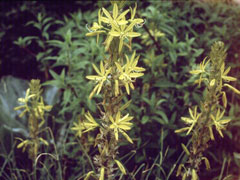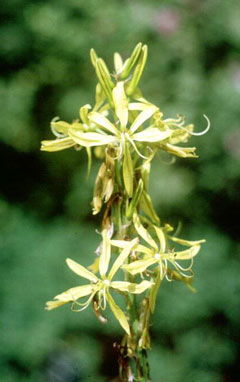 |
|
(c) 2010 Ken Fern & Plants For A Future |
 |
| (c) 2010 Ken Fern & Plants For A Future |
Translate this page:
Summary
Bloom Color: Yellow.
Main Bloom Time: Early summer, Late spring, Mid summer. Form: Upright or erect.
Physical Characteristics

 Asphodeline lutea is a PERENNIAL growing to 1 m (3ft 3in) by 1 m (3ft 3in) at a medium rate.
Asphodeline lutea is a PERENNIAL growing to 1 m (3ft 3in) by 1 m (3ft 3in) at a medium rate.
See above for USDA hardiness. It is hardy to UK zone 7 and is not frost tender. It is in flower from June to July, and the seeds ripen from July to September. The species is hermaphrodite (has both male and female organs) and is pollinated by Insects.
Suitable for: light (sandy), medium (loamy) and heavy (clay) soils and prefers well-drained soil. Suitable pH: mildly acid, neutral and basic (mildly alkaline) soils. It can grow in semi-shade (light woodland) or no shade. It prefers dry or moist soil. The plant can tolerate maritime exposure.
UK Hardiness Map
US Hardiness Map
Synonyms
Asphodelus luteus.
Plant Habitats
Woodland Garden Sunny Edge; Cultivated Beds;
Edible Uses
Edible Parts: Flowers Leaves Root Shoots
Edible Uses:
Root - roasted. This food was highly valued by the ancient Greeks, who roasted the roots like potatoes and ate them with salt and oil or mashed them with figs[2, 183]. The roots are not very thick but are abundantly produced and have a nice nutty flavour[K]. They can be harvested at any time of the year, but are best used when the plant is dormant in late summer and early autumn[K]. They do not store well and should be used within a few weeks of harvest[K]. Young shoots - cooked[K]. They smell less than pleasant whilst cooking but have a fairly bland flavour[K]. Some people find that they have a very pleasant flavour[K]. The plant comes into growth in late summer and the autumn, the young shoots can be harvested in moderation all through the winter[K]. Flowers - raw. A delightful sweetness, they are a very decorative and tasty addition to the salad bowl but should be used as soon as possible after harvesting because they soon start to decompose[K]. The flowers are very short-lived and are best picked in the late afternoon - thus you can enjoy them visually during the day and gastronomically in the evening[K]. There is also said to be a double-flowered form[245], which will have twice the quantity of petals, though we do not know its name[K].
References More on Edible Uses
Medicinal Uses
Plants For A Future can not take any responsibility for any adverse effects from the use of plants. Always seek advice from a professional before using a plant medicinally.
None known
References More on Medicinal Uses
The Bookshop: Edible Plant Books
Our Latest books on Perennial Plants For Food Forests and Permaculture Gardens in paperback or digital formats.

Edible Tropical Plants
Food Forest Plants for Hotter Conditions: 250+ Plants For Tropical Food Forests & Permaculture Gardens.
More

Edible Temperate Plants
Plants for Your Food Forest: 500 Plants for Temperate Food Forests & Permaculture Gardens.
More

More Books
PFAF have eight books available in paperback and digital formats. Browse the shop for more information.
Shop Now
Other Uses
References More on Other Uses
Cultivation details
Landscape Uses:Container, Foundation, Massing. An easily grown plant, it succeeds in ordinary garden soil[1, K], tolerating partial shade[200]. Requires a well-drained soil[42, 134], doing well in sandy soils[188]. Prefers a deep rich soil[111]. Prefers a soil that is not too rich and a warm sunny position[200]. Plants are hardy to about -15°c[187]. A very ornamental plant[1], though it looks very untidy in late summer when it dies down after flowering[K]. It seems to be very wind resistant, tolerating maritime exposure on an exposed site in Cornwall[K]. The flowers are sweetly scented[245]. Plants seem to be immune to the predations of rabbits[233]. Special Features:Attractive foliage, Naturalizing, Suitable for dried flowers, Fragrant flowers. The plant is heat tolerant in zones 9 through 6. (Plant Hardiness Zones show how well plants withstand cold winter temperatures.
Plant Heat Zones show when plants would start suffering from the heat.
The Plant Heat Zone map is based on the number of "heat days" experienced in a given area where the temperature climbs to over 86 degrees F (30°C).
At this temperature, many plants begin to suffer physiological damage. Heat Zones range from 1 (no heat days) to 12 (210 or more heat days).
For example Heat Zone. 11-1 indicates that the plant is heat tolerant in zones 11 through 1.) For polyculture design as well as the above-ground architecture (form - tree, shrub etc. and size shown above) information on the habit and root pattern is also useful and given here if available. The plant growth habit is a clumper with limited spread [1-2]. The root pattern is tuberous with swollen potato-like roots [1-2].
References Carbon Farming Information and Carbon Sequestration Information
Temperature Converter
Type a value in the Celsius field to convert the value to Fahrenheit:
Fahrenheit:
The PFAF Bookshop
Plants For A Future have a number of books available in paperback and digital form. Book titles include Edible Plants, Edible Perennials, Edible Trees,Edible Shrubs, Woodland Gardening, and Temperate Food Forest Plants. Our new book is Food Forest Plants For Hotter Conditions (Tropical and Sub-Tropical).
Shop Now
Plant Propagation
Seed - sow March/April in a greenhouse and only just cover the seed. Germination usually takes place in 1 - 3 months at 15°c[134]. Once the seedlings are large enough to handle, prick them out into individual pots and grow them on in the greenhouse for their first winter. Plant them out into their permanent positions in late spring. Division in spring or autumn, with care since the roots are easily damaged[1]. Ensure each division has at least one growing bud[200]. Large divisions can be planted out straight into their permanent positions, smaller ones are best potted up until they are growing away strongly and can then be panted out. We have found that this plant can be successfully divided throughout the growing season so long as it is watered in dry weather[K].
Other Names
If available other names are mentioned here
Native Range
TEMPERATE ASIA: Armenia, Georgia, Israel, Jordan, Lebanon, Syria, Turkey,Cyprus. EUROPE: Ukraine, Krym, Former Yugoslavia, Albania, Bulgaria, Greece (incl. Crete), Italy (incl. Sicily), Romania (southeast), AFRICA: Algeria (north), Tunisia.
Weed Potential
Right plant wrong place. We are currently updating this section.
Please note that a plant may be invasive in one area but may not in your area so it's worth checking.
Conservation Status
IUCN Red List of Threatened Plants Status :

Growth: S = slow M = medium F = fast. Soil: L = light (sandy) M = medium H = heavy (clay). pH: A = acid N = neutral B = basic (alkaline). Shade: F = full shade S = semi-shade N = no shade. Moisture: D = dry M = Moist We = wet Wa = water.
Now available:
Food Forest Plants for Mediterranean Conditions
350+ Perennial Plants For Mediterranean and Drier Food Forests and Permaculture Gardens.
[Paperback and eBook]
This is the third in Plants For A Future's series of plant guides for food forests tailored to
specific climate zones. Following volumes on temperate and tropical ecosystems, this book focuses
on species suited to Mediterranean conditions—regions with hot, dry summers and cool, wet winters,
often facing the added challenge of climate change.
Read More
Expert comment
Author
(L.)Rchb.
Botanical References
50200
Links / References
For a list of references used on this page please go here
Readers comment